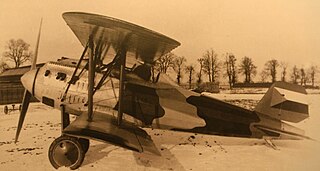
The Gloster F.5/34 was a British fighter of the 1930s. It was a single-seat, single-engine monoplane of all-metal cantilever construction; the undercarriage was of the tailwheel type with retractable main wheels.

The Fokker D.IX was a Dutch single seat, single engine fighter aircraft, the final, more powerful evolution of the Fokker D.VII World War I success, flown in 1921. The sole example was purchased by the US Army Air Service but not developed further.
The Hanriot HD.6 was a French two-seat fighter aircraft prototype, built towards the end of World War I though not flown until after the armistice with Germany. A biplane with an unusually narrow gap between upper and lower wings, powered by a single water-cooled radial engine, it did not enter production.

The Nieuport Nie 31 or Nieuport 31 was a single-engine, single-seat monoplane or sesquiplane fighter aircraft designed and built in France in 1919.

The Kondor D 6 was a prototype German biplane fighter aircraft flown in 1918. In the interests of better upward vision for the pilot, its upper wing was in two halves, separated over the central fuselage. Its development was soon abandoned.

The Pfalz D.VII was a German biplane fighter aircraft from World War I. It was not put into production.

The Pfalz D.VI was a German sesquiplane fighter aircraft from World War I. It was not put into production.

The Nieuport-Delage NiD 43 was a single-engine, two-seat biplane fighter aircraft designed and built for shipboard use in France in 1924.

The Loire-Nieuport 161 was a single-seat, single-engine, all-metal, low-wing monoplane fighter designed and built in France in 1935 to compete for a government contract. Accidents delayed its development and only three prototypes were completed.
The Wibault Wib 1, Wib C1 or, later, Wib 1 C1 was a French World War I single seat, single engine fighter aircraft prototype. Flown near the end of the war, it was not selected for production.

The Wibault 8 or Wib 8 Simoun (Simoon) was a tandem seat, parasol wing fighter aircraft designed and built in France to a 1925 specification which was later withdrawn; only one Wib 8 was completed.

The Wibault 13C.1 Trombe (Whirlwind), later known as the Wib 130C.1 Trombe was a single seat, parasol wing lightweight fighter aircraft designed and built in France in the 1920s. It was developed into the more powerful Wib 170C.1 Tornade (Tornado) but government interest in lightweight fighters soon waned.

The Wibault Wib 210 C.1 was a single engine, single seat low wing monoplane fighter aircraft, designed and built in France in the late 1920s. Flight tests revealed vibration problems and development was quickly abandoned.

The Letov Š-3 was a single-seat, single-engine parasol wing fighter aircraft designed and built in Czechoslovakia in the early 1920s. Only one was completed and flown, its makers preferring to develop a biplane fighter.

The Letov Š-7 was a single-seat, single-engine biplane fighter aircraft designed and built in Czechoslovakia in the early 1920s. It was designed for a single-seat fighter competition but did not reach production.
The Letov Š-22 was a single-seat, single-engine aircraft designed and built in Czechoslovakia in the mid-1920s. A parasol-wing Dewoitine-style fighter, it was not successful, and only one was built.
The Dewoitine D.15 was a single-engine, single-seat biplane fighter aircraft built in France in the 1920s. Intended to offer structural simplifications when compared with monoplanes, it had a disappointing performance and was soon abandoned.
The Ponnier M.1 was an early French World War I fighter aircraft Most of those produced were operated by the Aviation Militaire Belge. They were deemed unusable by the Belgian ace Willy Coppens and rapidly retired.

The LFG Roland D.XV was a World War I German single-seat fighter aircraft ordered as a test bed for engine comparisons. It was distinguished from earlier Roland biplane designs by the elimination of flying wires. Two later aircraft, also called LFG Roland D.XV, were completely different designs with slab-sided fuselages.

The FVM J 23 was a Swedish single seat, single engine, parasol wing fighter aircraft built in the mid-1920s. Five were flown but the type never reached operational status because of structural concerns raised by a fatal accident.















